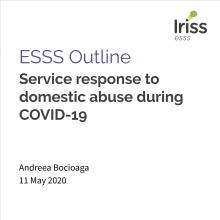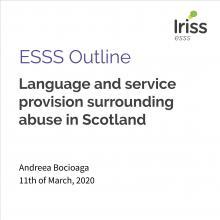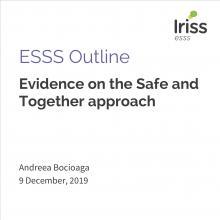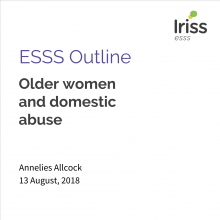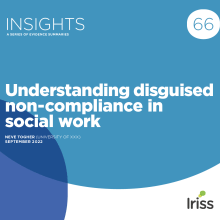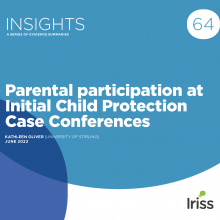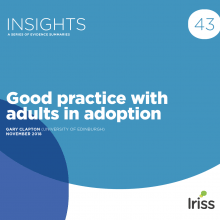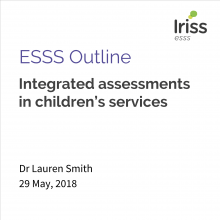Introduction
This evidence summary provides an overview of evidence relating to:
Adolescent to parent violence and abuse (APVA).
About the evidence presented below
We searched for academic research and grey literature using a wide range of search terms including: adolescent to parent violence, adolescent to parent violence and abuse, adolescent to parent abuse, adolescent violence towards parents, child to parent violence, child to parent violence and abuse, parent abuse, domestic abuse, and domestic violence.
It is acknowledged in the literature that there is a lack of high-quality studies investigating the prevalence and impact of adolescent to parent violence and abuse (APVA), and little evaluation of what interventions or support methods have been used or are in use. It is recognised that there is an urgent need for both an agreed definition of APVA, and a greater professional recognition and investigation of APVA. Research in this area continues to develop.
Accessing resources
We have provided links to the materials referenced in the summary. Some materials are paywalled, which means they are published in academic journals and are only available with a subscription. Some of these are available through the The Knowledge Network with an NHS Scotland OpenAthens username. The Knowledge Network offers accounts to everyone who helps provide health and social care in Scotland in conjunction with the NHS and Scottish local authorities, including many in the third and independent sectors. You can register here. Where resources are identified as ‘available through document delivery’, these have been provided to the original enquirer and may be requested through NHS Scotland’s fetch item service (subject to eligibility).
Where possible we identify where evidence is published open access, which means the author has chosen to publish their work in a way that makes it freely available to the public. Some are identified as author repository copies, manuscripts, or other copies, which means the author has made a version of the otherwise paywalled publication available to the public. Other referenced sources are pdfs and websites that are publicly available.
Definition
Adolescent to parent violence and abuse (APVA) was first differentiated from other forms of familial violence as ‘battered parent syndrome’ (Harbin and Madden, 1979), referring to:
“Any harmful act by a child, whether physical, psychological or financial, which is intended to gain power and control over a parent or carer”
It’s a term that has evolved since then, and while there remains a lack of consensus on definitions and terminology, it can be broadly seen as a pattern of habitual, coercive behaviours that reverse the parent / child power dynamic (Wilcox, 2012).
The term AVPA itself presents problems. It is likely ‘mother’ – as opposed to ‘parent’ – who is the recipient of APVA. Abuse also defines the child as an ‘abuser’ which is arguably an appropriate or helpful way of positioning someone under the age of 18 (Holt, 2011).
There is currently no legal definition of APVA. Depending on the age of the child, it may fall under the government’s official definition of domestic violence and abuse (Home Office, 2015):
“...any incident or pattern of incidents of controlling, coercive or threatening behaviour, violence or abuse between those aged 16 or over who are or have been intimate partners or family members regardless of gender or sexuality. This can encompass, but is not limited to psychological, physical, sexual, financial and emotional abuse.”
The UK Government’s draft Domestic Abuse Bill (HM Government, 2019) makes reference to APVA, but some feel it does not adequately capture its complexities, the experiences of families, or make a clear commitment to statutory support for those affected (Adoption UK, 2019).
There is no specific guidance for Scotland.
Prevalence
Despite recognition from practitioners, APVA has been, and continues to be, a relatively unexplored area. It is a particularly hidden form of domestic violence, and like other forms of domestic abuse is under-reported (Holt, 2011).
As policy has only recently begun to address the problem, incidents of APVA are not usually officially recorded or flagged, so prevalence is hard to gauge (Home Office, 2015). Without an understanding of the scale of the issues it is difficult to deliver appropriate policy and funding.
This lack of an agreed definition has resulted in the estimates of APVA varying between 3 and 27 percent (Gallagher, 2008; Holt, 2012a).
In 2009, Parentline Plus reported receiving an average of 95 calls to the helpline each month from parents concerned about their child’s verbal and / or physical aggression towards them: 91 percent of the callers were female, with the majority of children aged between 13 and 15 years (Holt, 2012b).
An analysis of Metropolitan Police Service statistics from 2009-10 on adolescent to parent violence, while limited, found 1,892 incidents of violence, threats of violence, or criminal damage in the home, perpetrated by a 13-19 year old towards a parent / carer (Home Office, 2015).
The national charity Family Lives reported in 2010 that their helpline received 22,537 phone calls from parents reporting aggression from their children, 7,000 of which involved physical aggression (Home Office, 2015).
International research, mainly from the US, Canada, Australia and Spain shows similar findings.
Who is affected?
Harbin and Madden (1979) examined 43 case studies, the majority involved male adolescents. A literature review from Kennair and Mellor (2007) suggests it is predominantly mothers, lone parents, and parents facing significant social and family stressors who are most likely to experience abuse from their children. From Metropolitan Police reports, Condry and Miles (2014) found that 87 percent of instigators were sons and 77 percent of victims were female, usually mothers. The Home Office Guide to APVA (2015) reports similar findings.
General population surveys tend to find no significant gender difference in the instigation of APVA. Studies based on police reports do find a gender divide, but the possibility of reporting bias should be noted here. There is a lack of research on whether mothers are more likely to report assaults than fathers, whether girls are more likely to use other forms of control, and whether police take assaults by boys on their mothers more seriously (Selwyn and Meakings, 2016).
Much of the research discusses APVA in relation to 10-18 year olds. The exploratory exercise from Thorley and Coates (2017a) suggests closer scrutiny around first noticed APVA, or behaviour beyond ‘normative’ expectations, should be given to younger children.
It may be that APVA is more likely to be identified or reported when families are already in contact with support services or the criminal justice system (Home Office, 2015), but it appears to affect all levels of society.
Causes
The first large-scale study of APVA in the UK was conducted by the University of Oxford from 2010 to 2013. The interviewed practitioners and parents described it as often involving a pattern of aggressive, abusive and violent acts across a prolonged period of time. It found that there was no single explanation for the abuse. A 2012 study, involving nine practitioners emphasised that there was no single cause of parent abuse, and therefore, no single solution (Holt and Retford, 2013).
Families described a range of reasons which they saw to be the cause of APVA, including substance abuse, mental health problems, learning difficulties, or a family history of domestic violence or self-harm.
Children who perpetrate parent abuse are more likely to have witnessed or experienced abuse or violence within the family home (Gallagher, 2008; Holt, 2009).
Impact
The impact of living with APVA has both an emotional and economic cost for families and wider society.
Those who experience APVA often suffer a great deal before seeking support. This is often linked to feelings of isolation, of failure as a parent, and the shame and stigma of having an abusive child (Home Office, 2015).
Almost all parents / carers reported a direct emotional cost for them, as well as on relationships with partners, siblings, wider family, and friends, all of which further increases feelings of isolation and loneliness (Thorley and Coates, 2017b; 2018).
The abuse can also cause health issues such as anxiety, depression, stress, loss of sleep, physical injury, sometimes leading to self-medicating with drugs and alcohol as a coping mechanism.
The economic costs associated with damage to the home and the person, alongside the loss of, or reduced, employment needs to be calculated. There is also the additional cost of support services from police, education and health and social care for families (Thorley and Coates, 2018).
Parental experience
Parents report feeling their parental rights are being subsumed by the children’s rights discourse. It has been suggested this is exacerbated by government policy framing the parent-child relationship in adversarial terms (Holt, 2011).
Parents are often reluctant to disclose or report violence from their child, fearing their parenting skills may be questioned or they will be disbelieved. Rather than receiving a responsive service, parents felt that professionals framed the difficulties as poor parenting (Selwyn and Meakings, 2016), which may contribute to the idea of these parents as in some way ‘deserving victims’, attracting less sympathy and support in comparison to others who experience family abuse (Holt, 2011).
The practitioners interviewed by Holt and Retford (2013) did explain that the issue was complex, and that many factors shape the ability to parent. They also shared concerns that the ‘child-centred’ orientation of social services may lead them to act in ways that are counterproductive.
The controlling elements of the child’s behaviour is often unrecognised by support services. And by the time they are involved, many parents have given up their parental ‘space’ within the family, and attempts to regain it, and reset roles and boundaries are thwarted (Selwyn and Meakings, 2016).
The pattern of professionals failing to recognise controlling behaviours and support parents continued for families whose children re-entered care. Young people usually insisted their parents be excluded from case conferences or reviews. Generally, social workers went along with these demands and parents described how professionals seem to take sides with the child (Selwyn and Meakings, 2016).
Where they are taken seriously, parents were concerned their child may be taken away from them and / or criminalised (Home Office, 2015).
Criminal justice
Criminal justice seems to be the standard response to APVA in the UK, and it’s one parents frequently resist (Holt, 2011). There are situations where it may be appropriate, but they may not want their child criminalised or removed from the family home. Out of court responses should be considered, which can mean typical domestic violence and abuse responses may not be appropriate (Hunter, 2012).
The removal of a child from the home to protect victims can clash with a parents responsibility to house their children, resulting in police often having no alternative but to returning the child home (Condry and Miles, 2014).
The concept of children as perpetrators of violence is itself problematic. Unlike adults they are not criminally responsible, and parents of young offenders are criminally responsible for them in ways that parents of adult offenders are not (Holt and Retford, 2013).
Support
Parents often don’t know where to go for support, their child’s behaviours don’t fit the criteria for support, or can find there is none available. When support services can be accessed, practitioners sometimes struggle to meet their needs or find information on existing programmes (Home Office, 2015).
Previous research (Nixon, 2012; Holt and Retford, 2013) has generally found response to APVA – from police, judiciary, youth services, social care, education, health services, and community / voluntary groups – to be generally inadequate.
The lack of definition and policy surrounding APVA can mean that perceptions of, and responses to it, are variable (Condry and Miles, 2014). The practitioners interviewed for Holt and Retford’s study (2013) agreed that in order for a multi-agency approach to work there needs to be clear policy and guidance for practitioners to follow.
Adoption UK’s response to the Draft Domestic Violence Bill (2019) state their members often find that the professionals working with them, do not have the knowledge, expertise and sensitivity around APVA and childhood trauma to adequately support them.
Research suggests that any approach to APVA should consider the family dynamic as a whole, not just the individual (Holt and Retford, 2013; Home Office, 2015).
The Home Office offers guidelines (2015) on how to respond to APVA for health, education, housing, police, youth justice and social care professionals.
Interventions
Holt (2011) makes the argument that perhaps the most effective area for intervention work is at a local level, where a number of different support services can focus specifically on ‘parent abuse’ within its own community and structural context. Programmes like Brighton and Hove’s Break4Change combined the efforts of local organisations with Community Child and Adolescent Mental Health Services and improved outcomes for both parents and children. It suggests that a non-punitive, multi-agency, whole-family approach is where thinking and practice should be heading.
Practitioners highlight the need for tailored responses to APVA. Without suitable interventions there is a higher risk of family breakdown, serious injury, damage to property, poor mental health for all concerned, and long-term risk to the safety and wellbeing of the young person (Home Office, 2015).
Parent / carer responses from Thorley and Coates (2018) Child Parent Violence and Abuse (CPVA) survey highlight suggestions for better support, including:
- Professionals to understand and appreciate what CPVA actually is
- Professionals supporting families living with CPVA to undertake training in CPVA
- CPVA guidance is developed for all professionals and support workers involved in the family unit overall to follow and recognise, detailing clear pathways
- Professionals to know how and where to access funding to enable interventions and training to be financed for families
Adoption
Research suggests adoptive families are disproportionately affected. In a 2017 joint-investigation by Adoption UK and BBC Radio 4, nearly two-thirds of parents said their adopted children displayed aggressive behaviour towards them. Further research from 2017 revealed that 30 percent of adoptive parents experience regular APVA (Thorley & Coates, 2017b).
Many adoptive families are known to encounter issues because of the child’s previous experience of trauma. In three percent of adoptive families this was serious enough to lead to adoption breakdown (Home Office, 2015).
Studies on adoption disruption in England and Wales identified adolescent parent violence (APV) as a significant factor. More than two thirds of the parents interviewed described sustained patterns of behaviours that met the definition of APV. The majority of the families who had experienced a disruption involved APV, as did seventeen of the forty-five families who were currently finding parenting very challenging (Selwyn and Meakings, 2016).
This indicates a need for APVA to be an essential part of any adoption preparation, and adoption support plans made at the time of placement need to be flexible enough to take account of changing circumstances (Selwyn and Meakings, 2016).
Domestic violence
Practitioners have tended to construct APVA around other forms of domestic violence, and responses built around this framework are often not appropriate – it’s a complex area of practice where the boundaries between victim and perpetrator aren’t clear (Holt and Retford, 2013).
The Draft Domestic Violence Bill (2019) addresses APV, but there is concern that by framing it around domestic abuse, and through an adult lens, it reinforces the sense of allocating blame to the child as the perpetrator, rather than an instinctive and protective behaviour pattern, and misses the opportunity to re-parent the child to develop better coping strategies (Adoption UK, 2019).
While they differ in a number of ways - the parent has an on-going responsibility to the child, so ending or leaving the relationship inappropriate, and the long-term solution is to remain together – there are similarities. The majority of victims / survivors are females / mothers, and they both involve a continuing process of abuse requiring day-to-day management (Holt, 2009).
The reasons are unclear, but there is a recognition that APVA is more likely to occur in families where children have been exposed to intimate partner violence (Cottrell and Monk, 2004; Hunter, 2010).
While there may not be a proven, causal connection, Wilcox (2012) argues that playing down or denying the link between domestic violence and parent abuse may be problematic. Framing APVA as a different form of domestic violence could help link parent abuse into existing multi-agency approaches with expertise of multiple forms of family violence.
Key papers
Condry R and Miles C (2014) Adolescent to parent violence: framing and mapping a hidden problem. Criminology & Criminal Justice, 14, 3, 257–275 (open access)
This article analyses victim, offender and incident characteristics from 1892 cases reported to the Metropolitan Police in 2009–2010. Findings broadly support previous international research, that APV is gendered: 87 percent of suspects were male, 77 percent of victims were female, and 66 percent of cases involved a son-to-mother relationship. They argue that criminology needs to have a nuanced understanding of family violence in all its forms, not just adolescents as offenders outside the home.
Coogan D (2014) Responding to child-to-parent violence: innovative practices in child and adolescent mental health. Health & Social Work, Volume 39, Issue 2, May 2014, Pages e1–e9 (open access)
This article examines the prevalence of child-to-parent violence and proposes a clear definition of child-to-parent violence for social work practitioners and researchers in mental health. It explores some of the obstacles in health and social care practice for the recognition and development of effective responses, including the Non-Violent Resistance Programme.
Holt A (2011) Responding to 'parent abuse'. The Psychologist, March 2011 24, 186-189 (open access)
This article looks at the conceptualisation, definition, and practice and policy responses to parent abuse. The author makes three suggestions for a psychology response: psychology is better placed to examine the complexities of the new theoretical frameworks needed to help conceptualise and understand ‘parent abuse; psychology has a role at practice level in supporting individuals, families and communities; and psychologists have a more critical role to play in informing policy makers about the ways in which government rhetoric can exacerbate and stigmatise families and individualise problems that are much more structurally complex.
Holt A (2016) Adolescent-to-parent abuse as a form of “Domestic violence”: a conceptual review. Trauma, Violence, & Abuse, 17, 5, 490–499 (open access)
This article reviews definitions and rates of APA and considers how the problem fits into the ‘family conflicts’ and ‘gender-based violence’ frameworks most frequently used to conceptualise domestic violence. The author looks at the shared characteristics and clear differences between adult-instigated domestic violence and APA, how they present challenges in dealing with it, and reviews APA intervention programs and their links with good practice from the domestic violence field.
Holt A and Retford S (2013) Practitioner accounts of responding to parent abuse – a case study in ad hoc delivery, perverse outcomes and a policy silence. Child & Family Social Work, 18, 365-374 (open access)
This study uses in‐depth interviews with nine practitioners from a range of agencies in an English county to explore how they each identify, conceptualise, explain and respond to parent abuse. With no national guidance regarding how agencies should respond to the problem, the authors find that practitioners must ‘make do’ without appropriate resources or policy to help them. The study offers suggestions of change for those seeking support but finding little effective response.
Home Office (2015) Information guide: adolescent to parent violence and abuse (APVA) (pdf)
The Home Office published guidance on adolescent to parent violence and abuse (APVA). Issues covered include safeguarding, risk assessment with young people and safety planning. Specific advice is included for professionals in healthcare, education, social care, housing, police and youth justice.
Hunter C and Christine P (2012) Parent abuse: can law be the answer? Social Policy and Society (open access)
This article reviews the different forms of legal interventions which may be available to address parent abuse, looks at the evidence and issues around them. It concludes that the criminal justice system is not suited to tackling the issue despite the most frequent response being police and criminal justice based. They argue that the law could be used more effectively to reduce the incidence and impact of parent abuse.
Moulds L and Day A (2017) Characteristics of adolescent violence towards parents – a rapid evidence assessment. Journal of Aggression, Conflict and Peace Research (open access)
This Rapid Evidence Assessment concludes that those who perpetrate AVTP typically experience high levels of comorbid mental health concerns, drug and alcohol use, anger difficulties and trauma. The parents are characterised as having strained relationships with other family members and trauma profiles. Policy and practice responses should be tailored to systemically address needs in the identified areas. The review further illustrates the limitations of current knowledge, highlighting inconsistencies in both definitions and findings.
O’Hara KL et al (2017) Adolescent-to-parent violence: translating research into effective practice. Adolescent Res Rev 2, 181–198 (open access)
This article looks at existing literature on adolescent-to-parent violence, reviews frameworks that guide research and practice, discusses the impact of inconsistent research methods on the current state of knowledge, integrates new data on risk and protective factors and assessment procedures, and details existing intervention approaches. The authors argue a collective, collaborative, and interdisciplinary effort by clinical scientists, mental health practitioners, and the legal community is needed to address the substantial consequences of APV.
Selwyn J and Meakings S (2016) Adolescent-to-parent violence in adoptive families. The British Journal of Social Work, 46, 5, 1224–1240 (open access)
This article highlights the prevalence of APV in the lives of families who had experienced an adoption disruption and those who were finding parenting very challenging in England and Wales. Two main APV patterns emerge: early onset (pre-puberty) that escalated during adolescence, and late onset that surfaced during puberty and rapidly escalated. The stigma and shame associated with APV delayed help seeking. The response from services was often to blame the adoptive parents and to instigate child protection procedures. There is an urgent need for a greater professional recognition of APV and for interventions to be evaluated with children who have been maltreated and showing symptoms of trauma.
Thorley W and Coates A (2017a) Child-parent violence (CPV): an exploratory exercise (open access)
Thorley W and Coates A (2017b) Child parent violence (CPV): exploratory exercise: Impact on parent / carers when living with CPV (open access)
Thorley W and Coates A (2017c) Child on parent violence: grappling with an enigma (open access)
These three reports present findings of survey data generated at the end of 2016, to open up more extensive discussions around CPV, explore the short- and long-term impact on mental and physical wellbeing for all members of the family unit, and interrogate definitions of CPV to show how it’s understood by families living with CPV and the professionals involved.
Wilcox P et al (2015) Responding to child to parent violence: executive summary (pdf)
This programme looked at the ways practitioners respond to CPV across five countries and examined whether violent and abusive behaviour by teenage children towards parents / carers can be changed. It focussed on two solution-focused intervention programmes – Break4Change and Non-Violent Resistance – which have been shown to work for the majority of families in the short term. The study indicates that parents and children also need longer term support to ensure that changes are embedded. It also highlights the varying levels of practitioner confidence, competence and knowledge with CPV, and the scarcity and lack of evaluation of training and specialised intervention programmes.
References
Adoption UK (2019) Draft Domestic Abuse Bill (pdf)
Biehal N (2012) Parent abuse by young people on the edge of care: a child welfare perspective. Social Policy and Society, 11, 2, 251-263 (paywall)
Calvete E, Orue I and Gámez-Guadix M (2013) Child-to-parent violence: emotional and behavioural predictors. Journal of Interpersonal Violence, 28, 4, 755–772 (open access)
Clarke K et al (2017) Adolescent‐to‐parent violence and abuse: parents' management of tension and ambiguity - an interpretative phenomenological analysis Child & Family Social Work, 2017; 22, 1423– 1430 (paywall)
Condry R and Miles C (2012) Adolescent to parent violence and youth justice in England and Wales. Social Policy and Society, 11, 2, 241-250 (paywall)
Condry R and Miles C (2014) Adolescent to parent violence: framing and mapping a hidden problem. Criminology & Criminal Justice, 14, 3, 257–275 (open access)
Coogan D (2011) Child-to-parent violence: challenging perspectives on family violence. Child Care in Practice, 17, 4, 347-358 (open access)
Coogan D (2014) Responding to child-to-parent violence: innovative practices in child and adolescent mental health. Health & Social Work, 39, 2, e1–e9 (open access)
Cottrell B and Monk P (2004) Adolescent-to-parent abuse: a qualitative overview of common themes. Journal of Family Issues, 25, 8, 1072–1095 (open access)
Department for Education (2014) Beyond the adoption order: challenges, interventions and adoption disruption - research report (pdf)
Edenborough M et al (2008) Living in the red zone: the experience of child‐to‐mother violence. Child & Family Social Work, 13, 464-473 (paywall)
Gallagher E (2008) Children‘s violence to parents: a critical literature review Unpublished Master of Social Work, Monash University, Australia (pdf)
Gordon C and Wallace K (2015) Caring for those who care for violent and aggressive children (pdf)
Harbin HT and Madden DJ (1979) Battered parents: a new syndrome. The American Journal of Psychiatry, 136, 10, 1288–1291 (paywall)
HM Government (2019) Transforming the response to domestic abuse consultation response and draft Bill (pdf)
Holt A (2009) Parent abuse: some reflections on the adequacy of a youth justice response. Internet Journal of Criminology (open access)
Holt A (2011) Responding to 'parent abuse'. The Psychologist, March 2011, 24, 186-189 (open access)
Holt A (2012a) Adolescent-to-parent abuse: current understandings in research, policy And practice. Bristol: Bristol University Press
Holt A (2012b) Researching parent abuse: a critical review of the methods. Social Policy and Society, 11, 2, 289-298 (open access)
Holt A (2015) Working with adolescent violence and abuse towards parents approaches and contexts for intervention London: Routledge
Holt A (2016) Adolescent-to-parent abuse as a form of ‘Domestic violence’: a conceptual review. Trauma, Violence, & Abuse, 17, 5, 490–499 (open access)
Holt A and Retford S (2013) Practitioner accounts of responding to parent abuse – a case study in ad hoc delivery, perverse outcomes and a policy silence Child & Family Social Work, 18: 365-374 (open access)
Home Office (2015) Information guide: adolescent to parent violence and abuse (APVA) (pdf)
Holes in The Wall (website)
Hong JS et al (2012) The Social Ecology of Adolescent-Initiated Parent Abuse: A Review of the Literature Child Psychiatry Hum Dev 43, 431–454 (open access)
Hunter C, Nixon J and Parr S (2010) Mother Abuse: A Matter of Youth Justice, Child Welfare or Domestic Violence? Journal of Law and Society, 37: 264-284 (open access)
Hunter C and Christine P (2012) Parent Abuse: Can Law Be the Answer? Social Policy and Society (open access)
Ibabe I (2019) Adolescent-to-Parent Violence and Family Environment: The Perceptions of Same Reality? Int. J. Environ. Res. Public Health 2019, 16(12), 2215 (open access)
Kennair N and Mellor D (2007) Parent Abuse: A Review Child Psychiatry Hum Dev 38, 203 (open access)
McCloud E (2017) Adolescent-to-Parent Violence and Abuse (APVA): An Investigation into Prevalence, Associations and Predictors in a Community Sample (pdf)
McElhone G (2017) Child to parent violence: an analysis of the perceptions of perpetrator and victim gender when considering offending and victimisation Journal of Applied Psychology and Social Science, 3 (1). pp. 5273 (pdf)
Miles C and Condry R (2016) Adolescent to parent violence: the police response to parents reporting violence from their children Policing and Society, 26:7, 804-823 (paywall)
Moulds L et al (2016) Adolescent Violence Towards Parents - The Known and Unknowns Australian and New Zealand Journal of Family Therapy 2016, 37, 547 - 557 (open access)
Moulds L and Day A (2017) Characteristics of adolescent violence towards parents – a Rapid Evidence Assessment Journal of Aggression, Conflict and Peace Research (open access)
Moulds LG et al (2019) Adolescent Violence Towards Parents: A Case of Specialisation? Youth Justice, 19(3), 206–221 (open access)
Murphy-Edwards L and van Heugten K (2018) Domestic Property Violence: A Distinct and Damaging Form of Parent Abuse Journal of Interpersonal Violence, 33(4), 617–636 (open access)
Nixon J (2012) Practitioners' Constructions of Parent Abuse Social Policy and Society, 11(2), 229-239 (paywall)
Nowakowski-Sims E and Rowe A (2015) Using Trauma Informed Treatment Models with Child-to-Parent Violence Journ Child Adol Trauma 8, 237–244 (open access)
O’Hara KL et al (2017) Adolescent-to-Parent Violence: Translating Research into Effective Practice Adolescent Res Rev 2, 181–198 (open access)
Parentline Plus (2010) When family life hurts: Family experience of aggression in children (pdf)
RCPV (2016) Non Violent Resistance Handbook for Practitioners – Responding to Child to Parent Violence in Practice (pdf)
Routt G and Anderson L (2011) Adolescent Violence towards Parents Journal of Aggression, Maltreatment & Trauma, 20:1, 1-19 (open access)
Selwyn J and Meakings S (2016) Adolescent-to-Parent Violence in Adoptive Families The British Journal of Social Work, Volume 46, Issue 5, July 2016, Pages 1224–1240 (open access)
Tew J and Nixon J (2010) Parent abuse: opening up a discussion of a complex instance of family power relations Social Policy and Society, vol. 9, no. 4, pp. 579-589 (open access)
Thorley W and Coates A (2017a) Child - Parent Violence (CPV): an exploratory exercise (open access)
Thorley W and Coates A (2017b) Child Parent Violence (CPV): exploratory exercise: Impact on parent / carers when living with CPV (open access)
Thorley W and Coates A (2017c) Child on Parent Violence: Grappling with an Enigma (open access)
Thorley W and Coates A (2018) Let's Talk About: Child-Parent Violence and Aggression (CPVA) 2018 Survey Extended summary (open access)
University of Bristol (2019) Child to Parent Violence Project 2017-2018 Final report (pdf)
University of Oxford Adolescent to Parent Violence (website)
Wilcox P (2012) Is Parent Abuse a Form of Domestic Violence? Social Policy and Society. 11. 277 - 288 (open access)
Wilcox P et al (2015) Responding to Child to Parent Violence: Executive Summary (pdf)
Williams M et al (2017) “It's like he just goes off, BOOM!”: mothers and grandmothers make sense of child‐to‐parent violence Child & Family Social Work, 22: 597– 606 (paywall)
Suggested reference: Sanders, R (2020) ESSS Outline: Adolescent to parent violence and abuse (APVA). Iriss. https://doi.org/10.31583/esss.20200311

